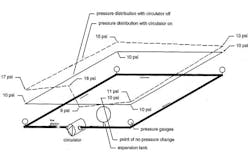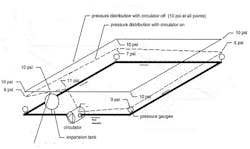What is the ‘point of no pressure change,’ and why should you care?
In all the years that I have been writing and teaching, I have found that one of the hardest concepts for people in the hydronics business to understand is the concept and explanation surrounding what has been called the “point of no pressure change,” or PONPC. This concept is very simple, but hard to explain, and even harder for people to see it in their mind’s eye.
During a recent code hearing, it was pointed out to me that the pressure at the PONPC will in fact change due to expansion and contraction of the working fluid, so the name is somewhat misleading. With that in mind, I propose that we as an industry adopt a new, better, more accurate name for this critical location. I propose that we call it the “point of no mechanically induced pressure change,” or PONMIPC.
Essentially, the PONMIPC is that place in the system to which the expansion tank is connected. Regardless of the pump’s location in relationship to this point, it cannot cause any mechanically induced pressure changes at this point.
As I pointed out in my last article, pumps and circulators are really nothing more than pressure differential machines, or as I tagged it in those articles, PDMs. Quite honestly, PDMs don’t care whether they create positive energy, negative energy, or half and half. Their only function in life is to create a pressure “differential,” and by golly, that is all they do. That differential in pressure equates to fluid movement, and without that, pardon the pun, we are “dead in the water” (gravity-induced or thermosyphonic circulation excluded).
Our industry friend Dan Holohan actually wrote a great book about this special place in hydronic systems, and called it “Pumping Away” (available at www.heatinghelp.com). People got Dan’s concept a little misconstrued, because they thought the boiler was the PONPC. And if the expansion tank is connected to the boiler, that statement is true. In newer systems, the expansion tank is rarely connected directly to the boiler, so the PONPC/PONMIPC is actually the expansion tank. Don’t worry about the boiler. We will discuss its importance in a future article as it pertains to air removal, but for now, let’s stick with the PONMIPC principle.
So, why should a person really worry about this PONMIPC and the pump’s location in relationship to it? I used to tell my students, “Don’t worry about the physics, just do as you are told (pump away from the expansion tank) and your life and the lives of the people who live with these systems will be much better.” That is still true today, but I need to explain it in more detail so people understand why it is so important.
Basically, air in suspension will come out of suspension if exposed to a negative pressure, or even just a slight drop in pressure. Air is the enemy of good, quiet fluid flow. We want all pressure generated by the PDMs to be positive, so it keeps the air in suspension and allows the PDM to move it to the one place where it is wanted to come out of suspension, be captured and expelled (in newer systems — older systems recover this air and direct it back to the “cushion” tank).
For those of you who are thinking, “But what about the millions of systems out there with the pumps on the system returns that are pumping toward the expansion tank connection? They still work …” True that. Noisily, but they do still work to move the fluid around the system. But those older three-piece pumps were a relatively flat curved circulator. They are not capable of generating any significant pressure differential. They’d still work much better pumping away from the PONMIPC, but they do perform adequately in that location. Many, if not most, PDMs on the market today are a steeper curved device, and placing them in the same position as the flat curved three-piece circulators is a guaranteed way to create a noisy, troublesome, air-bound system.
Bell and Gossett produced a beautifully simple diagram to explain what difference the PDM’s location in relationship to the PONMIPC makes. (See graphics below and above; images courtesy of Bell and Gossett, a Xylem company.)
As you can see, it does make a difference. Add some height to the system, add a few of those handy automatic air vents to the top of the system, and allow the fill pressure to become just a little low. Suddenly, instead of being an air vent, when a high head PDM that is pumping toward the PONMIPC turns on, these devices become vacuum breakers. The system gets extremely noisy and becomes air bound to the point that circulation stops, and your phone starts ringing with a cold, unhappy customer on the other end.
Now can you see the concept in your mind’s eye? As has been said by every hydronics writer I am familiar with, pump away from the expansion tanks’ connection to the system, and the system will work perfectly and silently. That’s the most important thing for you to know.
If you are not yet a member of the Radiant Professionals Alliance, please consider joining this very worthwhile organization where we continue to educate our contractor members. Visit www.radiantpros.org.
Mark Eatherton material on this website is protected by Copyright 2016. Any reuse of this material (print or electronic) must first have the expressed written permission of Mark Eatherton and CONTRACTOR Magazine. Please contact via email at: [email protected].
About the Author
Mark Eatherton
Mark Eatherton material on this website is protected by Copyright 2017. Any reuse of this material (print or electronic) must first have the expressed written permission of Mark Eatherton and CONTRACTOR Magazine.



